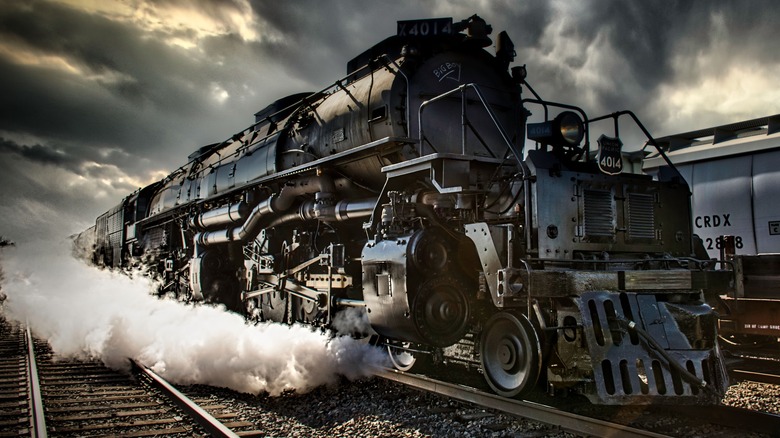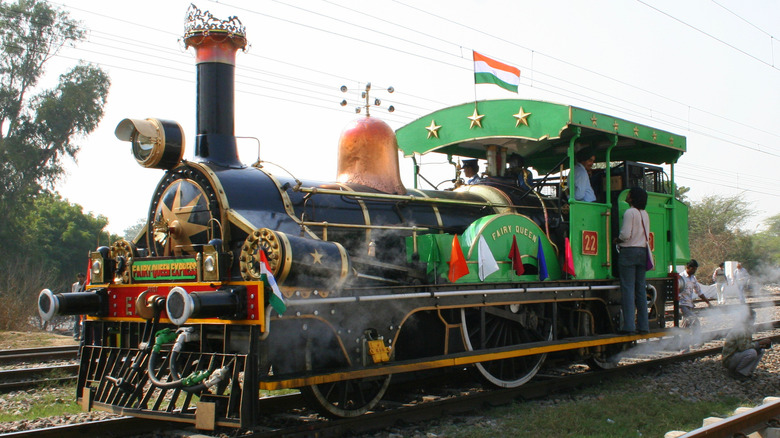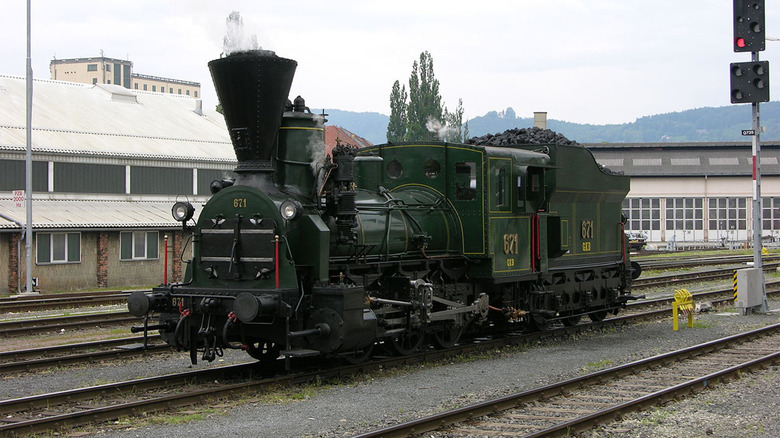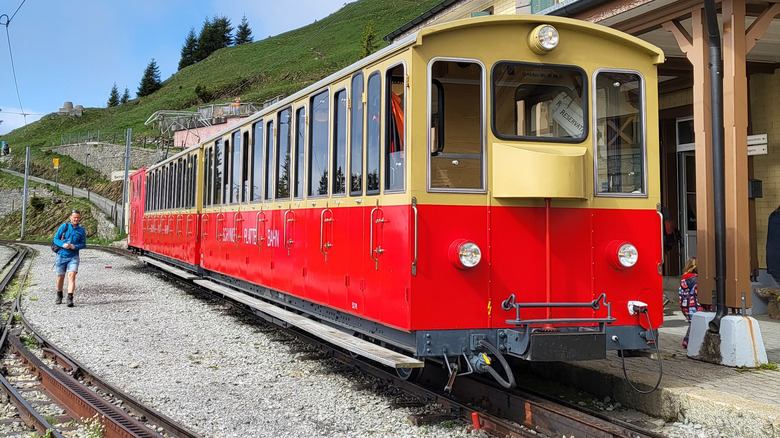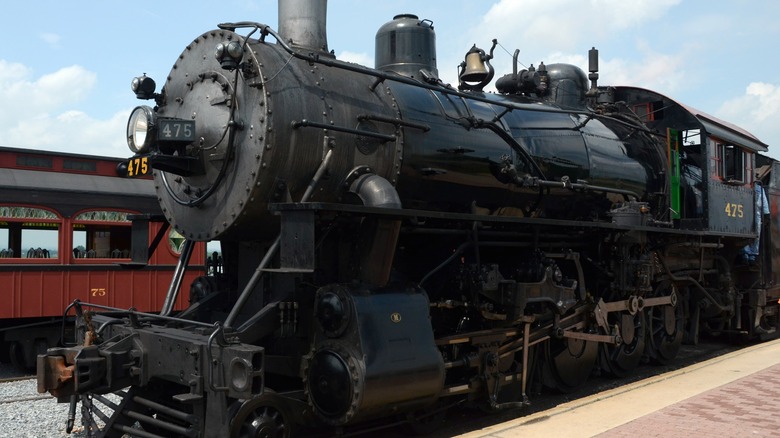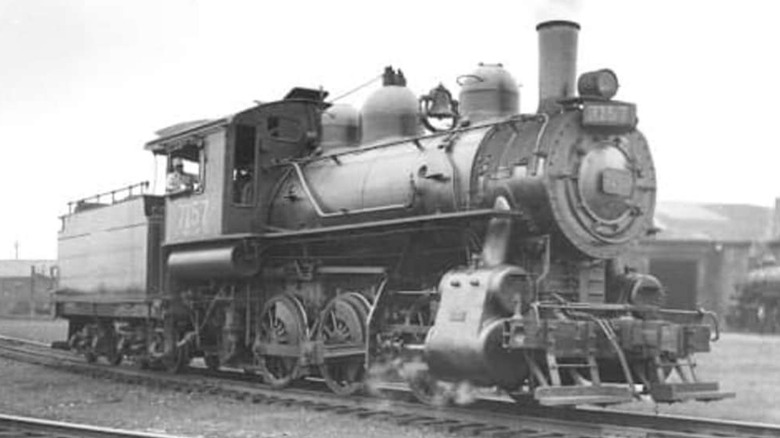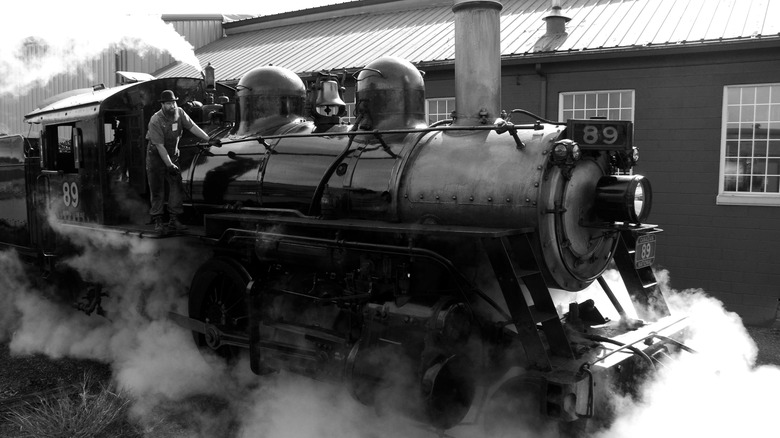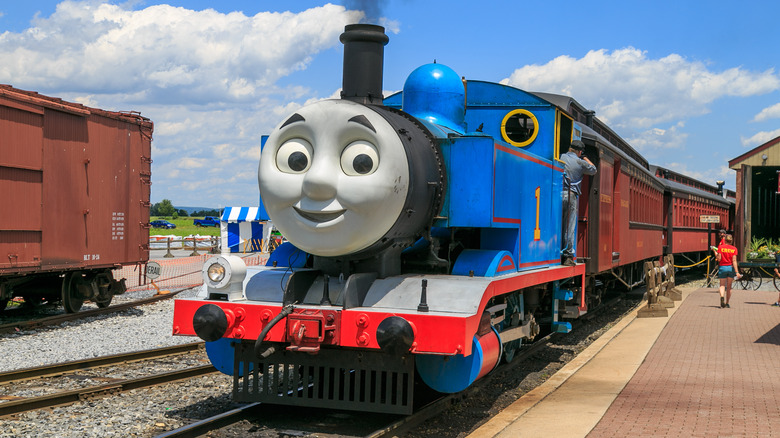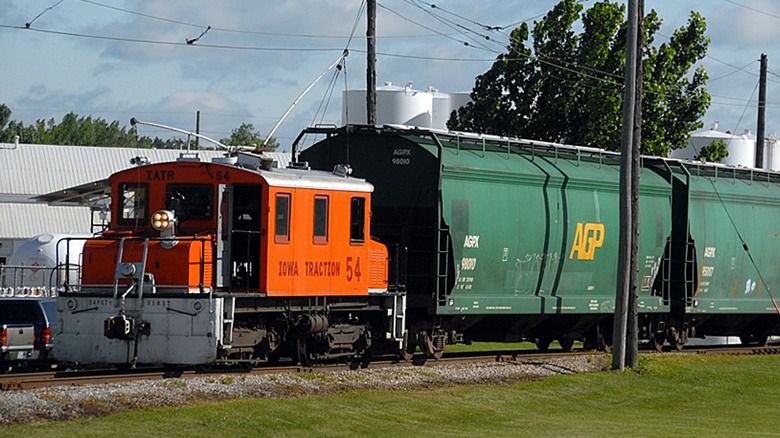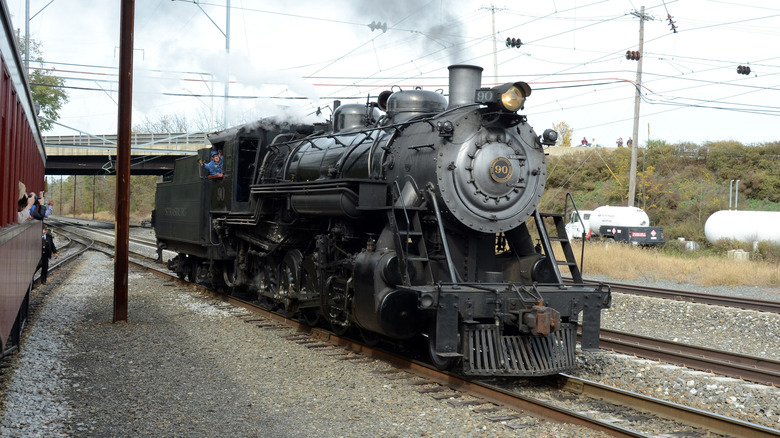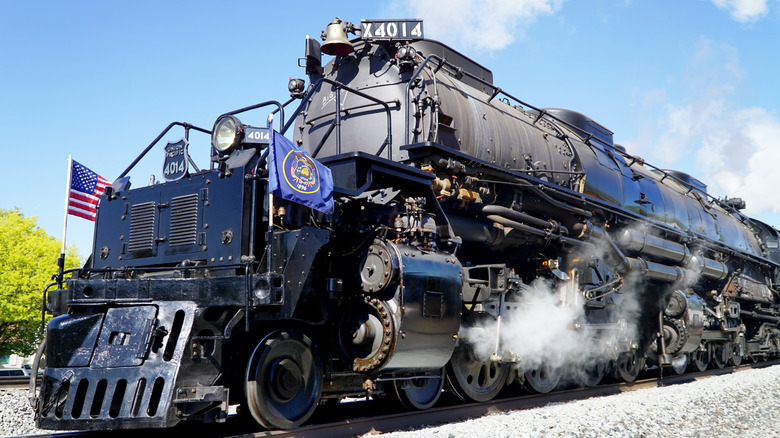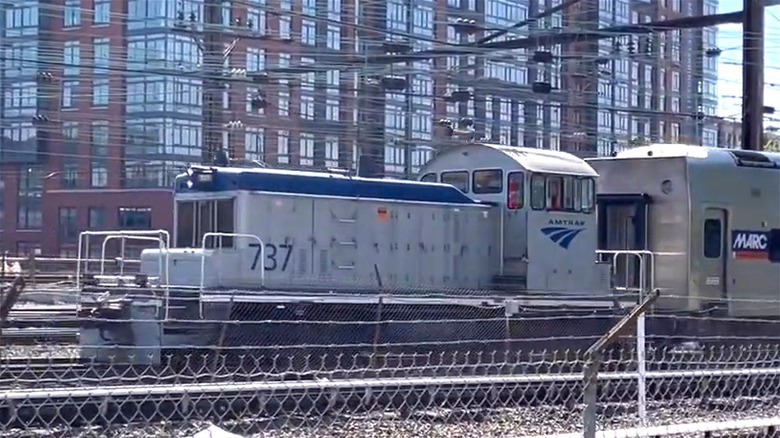11 Of The Oldest Locomotives Still In Service Today
Locomotives have a fascinating history. They were one of the first methods to mass transport goods from one place to another, and while the first railroads used horses to pull carts along the tracks, steam locomotives hit the scene in 1802 and have improved over time. Long gone are the days when operators had to shovel coal into a fire to generate the steam used to run these things. The oldest surviving locomotive is Puffing Billy, a steam locomotive from 1813. It doesn't run anymore, but you can find it on display at the Science Museum in London.
These days, modern locomotives use diesel, biodiesel, hydrogen, and even electricity to power their way down the tracks, with the goal of increasing efficiency while decreasing emissions. Today, freight railroads account for 0.5% of U.S. greenhouse gas emissions. That's not half bad, and it's improving regularly.
However, much like military vehicles such as helicopters, locomotives are expensive to replace. They also don't get produced on a massive scale, which means a lot of older locomotives are still on the rails today. Older locomotives are generally used for things like tourism and passenger transport, leaving the heavy lifting to modern, more fuel-efficient machines. However, there are some older locomotives that still put in a hard day's work like their more modern counterparts — here are some of the oldest locomotives still in service today.
The Fairy Queen
The Fairy Queen is the oldest locomotive that is still in service today. It was manufactured in 1855 and has been active on and off ever since. The locomotive typically ran between Howrah and Raniganj in India. Around 1909, the locomotive was put on display at the Howrah station where it remained stationary for a few decades. India's government designated it as a national treasure in 1972 and placed it in National Rail Museum in New Delhi. The Fairy Queen enjoyed a 35-year stay there before it was overhauled and returned to service.
These days, The Fairy Queen generally hauls tourists and enthusiasts. It runs on the second and fourth Saturdays of each month from October until March every year. Passengers enjoy a scenic trip from Delhi to Alwar and back again. The Fairy Queen only hauls two coaches worth of passengers, so it's definitely not the hardest-working train on our list.
The Fairy Queen has won some prestigious awards. It's the current Guinness World Record holder for the oldest train still in operation, and India's Ministry of Tourism also awarded The Fairy Queen a National Tourism Award in 1999. Thankfully, the light workload should keep this award winner in operation for a long time.
GKB 671
The GKB 671 was built all the way back in 1860. It's part of the Südbahn Class 23 series of locomotives that were designed to haul freight. The GKB 671 started life at the Federal Railway of Austria (BBÖ). Over the years, locomotives from this series were rebranded, renamed, and moved around to a couple of other countries, including Yugoslavia, Hungary, and Italy. Only one locomotive from the series remains, and it's the GKB 671. It's part of the Graz-Köflach railway, and it still runs to this day.
Further history about this locomotive is a bit difficult to pin down because GKB 671 hasn't spent hardly any time in the limelight. It was designed to haul things and hauling things just isn't the most exciting task. Its brethren, the Südbahn 718 and the GKB 680 reside in the Slovenian Railway Museum and the German Museum of Technology, respectively. There is no doubt the GKB 671 will join the other two in a museum when it inevitably retires.
The impressive part of the GKB 671 is that it never remained inactive for very long. It's had some downtime for repair and modernization from time to time but never had any significant downtime. These days, the locomotive carries some passenger cars a few days a month for tourism, but that's about it.
[Image by Stefan Partl via Wikimedia Commons | Cropped and scaled | CC BY-SA 3.0]
Schynige Platte Railway locomotives
The Schynige Platte Railway is a unique case. It's a mountain railway located in the Bernese Highlands of Switzerland, a country with all sorts of steep and interesting train routes. The railway operates a number of locomotives, and many of them are ancient by today's standards. The railway's oldest locomotive is the H 2/3 which was built in 1894. Other old locomotives in the rolling stock include the Wilderswil, Gsteigwiler, Matten, and Gündlischwand, all of which were built in 1914, alongside a smattering of others from 1910, 1911, and 1912. Every one of them is still in use today and they are all used for passenger transport.
The oldest, the H 2/3, is an old-school steam locomotive, while the rest of them are all-electric. You can tell by their odd shape and their connection to powerlines that run above the railway. The steam locomotive goes down for service every now and then but still runs regularly for tourists. More impressively, the electric locomotives still run their regular schedules as they have since they were put into service. Guests are treated to an unobstructed view of the nearby landscape, which is absolutely pristine.
Perhaps the most unique part of this railway and its trains is that each locomotive has spent its entire operating life on the same railway. Most old trains switch hands and railroads from time to time, but that's not the case here. The entire rolling stock at Schynige Platte Railway has been there since they were built. That's a neat piece of history.
Norfolk and Western 475
The Norfolk and Western 475 is a steam locomotive from 1906. It started life at the Norfolk and Western Railway where it operated on various routes until its retirement in 1957. Most of its trips were for freight, so it lived a fairly uneventful life. The locomotive spent some time in the hands of private collectors for the next several decades before winding up on the iconic Strasburg Rail Road in 1993, where it underwent a $600,000 restoration. Afterward, it was returned to service for passenger use.
The locomotive, which looks like something out of a Western flick, has had a much more eventful life since then. For instance, the Strasburg Rail Road was the shooting site for the 200 film "Thomas and the Magic Railroad," and the Norfolk and Western 475 was featured in several scenes. It's also consistently painted like its sister locomotives for use in things like photoshoots. There was even an accident back in 2022. Luckily, no one was harmed, and the locomotive was repaired quickly.
One of the other things that makes the Norfolk and Western 475 special is its power. It's capable of pulling just about anything on a railroad, making it ideal for passengers or freight. Granted, it doesn't haul freight anymore — but it could if someone wanted it to.
Canadian National 7312
The Canadian National 7312 was built in 1908 and refurbished in 1960. The locomotive was originally used for freight on the Canadian National Railway. It spent its entire operational lifetime there and was retired in 1957.
In 1960, it was purchased by the Strasburg Rail Road and become part of its rolling stock. The Strasburg Rail Road used it for both passenger and freight services for decades before eventually dropping it down to just passenger use, making No. 7312 the first steam locomotive to reenter passenger service in U.S. history. In 2009, it was removed for its mandatory FRA inspection and overhaul. Unfortunately, the project remains incomplete. New leadership at Strasburg was put in place to finish these old projects, so the 7312 should be back on its feet sometime soon. Such long maintenance times are rather uncommon, so this doesn't happen often.
There is no indication of what the 7312 will be used for once it's back in service. The most likely scenario is as a tourist attraction like many of the other heritage locomotives in the Strasburg lineup. It's powerful enough to pull anything, but steam engines aren't ideal for moving cargo anymore.
[Image by Mizzinno via Wikimedia Commons | Cropped and scaled | CC BY-SA 4.0]
Canadian National 89
The Canadian National 89 followed a very similar life to the Canadian National 7312. It was manufactured in 1910 and put into service for the Canadian National Railway. It underwent renumbering multiple times over the years before it settled on number 89. The 89 also served a stint at the Grand Trunk Railway as number 1009. It wound up at the Green Mountain Railroad, where it remained until 1972 when Strasburg Rail Road purchased the locomotive. Unlike many other locomotives, the Canadian National 89 never really retired.
Once at Strasburg, the 89 has continued operating as a passenger locomotive. It completed inspections as recently as 2016, so it still has a long life ahead of it. The 89 often runs with other locomotives in Strasburg's lineup, and that includes the Norfolk and Western 475.
These days, the Canadian National 89 works as an excursion train where it hosts tourist rides and special events at Strasburg. That's quite a nice retirement from its old days of hauling freight. It's also one of the few locomotives from this era that hasn't spent extensive time in a museum or completely inactive, which makes it a little special.
Brooklyn Eastern District Terminal 15
The Brooklyn Eastern District Terminal 15 is an 0-6-0 style steam engine that was built in 1917. It served the Brooklyn Eastern District Terminal for almost its entire operational life. The engine would wait dockside for cargo to be loaded and then haul it around New York to wherever it needed to go. It was retired in 1963 before being purchased by Southern Appalachian Railway in 1965. Eventually, it was sold to the Toledo, Lake Erie and Western Railway where it sat on display for decades. You've heard this next part of the story a few times already — Strasburg Rail Road purchased No. 15 in 1998.
After its purchase by Strasburg, it underwent some restorations. Then, the most interesting part of this locomotive's history happened. It was restored to be a life-sized replica of Thomas the Tank Engine for use in the movie "Thomas and the Magic Railroad" and other media. The locomotive has worn the Thomas paint job ever since, and it's mostly used today for special events and tourism rides. As you can imagine, it's quite popular with kids.
Strasburg often lends the 15 to other railways for special Thomas the Tank Engine-related events. That's essentially how this locomotive spends its days. It's easily among the most noticeable steam-powered trains still running today, and it should continue to run for a while since its workload isn't too strenuous.
IATR 50 and IATR 54
The IATR 50 and IATR 54 were built in 1920 and 1923, respectively, and have been with the Iowa Traction Railway Company for most of the last half a century. The IATR 50 spent time with the Cedar Rapids & Iowa City Railroad and the Kansas City Kaw Valley Railroad before it ended up with the IATR. The IATR 54 started at the Southern Iowa Railway before eventually winding up with the IATR also. Both locomotives look very similar, with striking orange paint jobs and a distinctive steeple design.
In addition, both locomotives use electricity to get around. They attach to a power line that runs above the railroad that delivers power to the locomotive throughout their trip. This has not only aided in their longevity but also helped them remain relevant in modern times, unlike their steam engine counterparts. Even their routes have remained more or less the same.
These locomotives are still active to this day. Unlike most, they haven't been converted into tourist attractions or heritage locomotives. The IATR used to provide passenger service many decades ago but abandoned it when people switched to cars and off of public transportation. Barring a total breakdown, these should continue to haul cargo for a long time.
[Image by Mizzinno via Wikimedia Commons | Cropped and scaled | CC BY-SA 2.0]
Great Western 90
The Great Western 90 is one of the longest-tenured locomotives in the Strasburg Rail Road lineup. It was originally built in 1924 by the Baldwin Locomotive Works. Originally, it served on the Great Western Railway of Colorado. Unlike most locomotives, which pull all types of freight, the Great Western 90 was best known for hauling sugar beets. The Great Western Railway of Colorado sold the locomotive to Strasburg in 1967 where it has been ever since. Much like the rest of Strasburg's lineup, the Great Western 90 is used for tourism and special event trips — its days of sugar beet hauling are long over.
The 90 has had a rather soft history compared to many of its contemporaries. It has been loaned to other railways for excursion use, but otherwise it's been remarkably consistent with few issues or serious overhauls, although the engine was involved in a fatal accident back in 1944 when it was hit by a truck. Tragically, two people died in the incident.
Things have picked up for the locomotive in modern times. While its mandatory FRA inspection and overhaul came up in 2023, the Great Western 90 is Strasburg's biggest and strongest engine, so it shouldn't remain out of service for any longer than it needs to.
Union Pacific 4014
The Union Pacific 4014 was built in November 1941 as part of a series of locomotives known as the Big Boys. There were 25 in the production run, but 4014 is the only one that is still operational. The 4014 was owned by Union Pacific for its entire operational life, which was only about 20 years. In that time, it traveled over one million miles. It was retired in 1961 when it was sent to a museum. Union Pacific reacquired the 4014 from the RailGiants Museum in Pomona, California in 2013. After a six-year overhaul, the Big Boy returned to service in 2019 for Union Pacific's heritage program.
This thing is absolutely massive. The Big Boys measured over 132 ft long and weighed an incredible 1.2 million pounds. If stood up on its hind end, the Big Boy would be nearly 10 stories tall. It has a maximum tractive power of 135,375 lbs, making it one of the strongest steam locomotives ever produced. Even outside of steam power, it ranks among the top contenders. The only reason it was retired was because more efficient diesel and gas-turbine engines were coming out.
These days, the 4014 is a heritage engine. It's mostly used for tourism, and the legendary locomotive goes on tours in various parts of the U.S. so folks can see and ride on a train pulled by the 4014.
Amtrak 737
The Amtrak 737 is the oldest engine still on Amtrak's train service. It's an EMD SW1 locomotive that was originally built in 1942, and it uses a diesel-electric engine that was produced from 1938 to 1953. There are other SW1s in operation, but this one appears to be the oldest. It regularly runs in Washington D.C. and Wilmington. This particular model was purchased by the New York Central Railroad. Eventually, it moved over to Penn Central ownership where it underwent a renumbering. Finally, Amtrak bought the engine in 1977 when it was renumbered again to the 737. It's been in operation ever since.
There isn't much to the history of this engine. It's been in service since its manufacture, and it's a fairly humdrum locomotive overall. The diesel-electric engine creates a fairly average amount of horsepower as it hauls people from point A to point B. It's been repainted a couple of times by its various owners, but it's nothing so dramatic as the Brooklyn Eastern District Terminal 15. This machine is the proverbial blue-collar worker. It reliably does its job every day without complaint, but that's a compliment in and of itself.
Every now and then, an appreciation post for Amtrak's oldest locomotive goes up on r/trains, but that's about all the fanfare this little locomotive receives. It'll get retired eventually, but until then — if it ain't broke, don't fix it.
